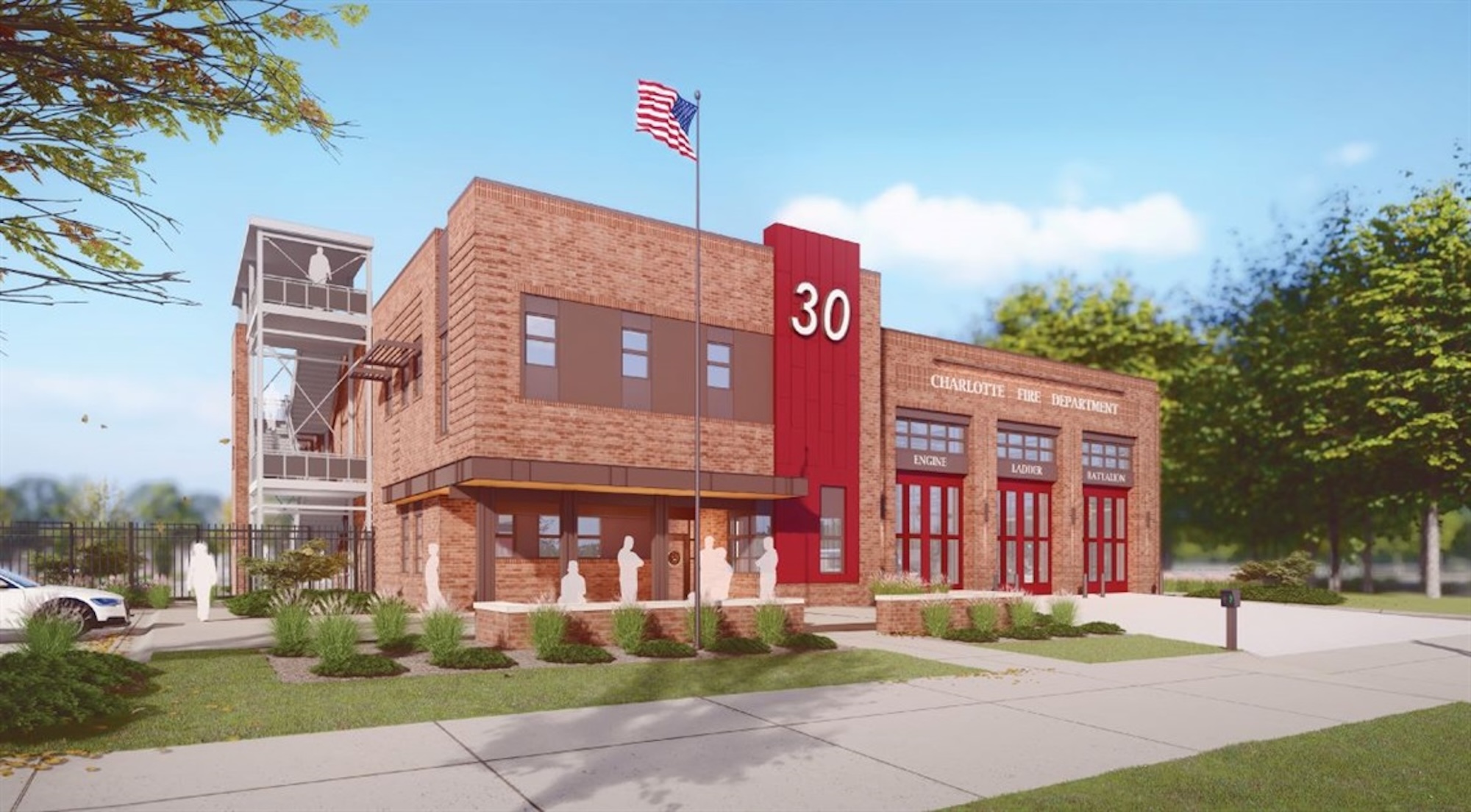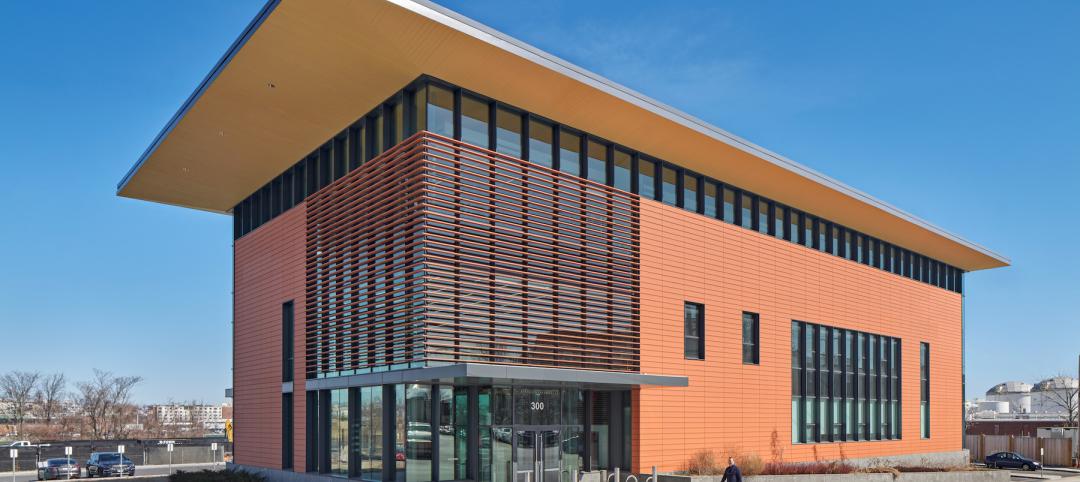Charlotte, N.C.’s new Fire Station #30 will be one of the country’s first all-electric fire stations, using no outside energy sources other than diesel fuel for one or two of the fire trucks. Multiple energy sources will power the station, including solar roof panels and geothermal wells. The two-story building features three truck bays, two fire poles, dispatch area, contamination room, and gear storage.
The $16.4 million, 14,000 sf station will be completed next fall. It will replace the original Station #30, a 1950’s-era residential home that was converted to a fire station in 1991. The new two-story building includes a fitness area with locker rooms, a kitchen and dining facility, a day room lounge, and offices for the captain and battalion chief. The second floor houses sleeping quarters and additional lockers and restrooms.
Geothermal wells will supply air conditioning as well as energy-efficient floor heating. Electric vehicle charging stations will charge the electric fire truck with additional wiring installed for future EV chargers. The site will also include two EV parking stations for employee cars.
RELATED STORY
Modular fire station allows for possible future reconfigurations
Core and shell construction includes the installation of new storefront systems of wall paneling and brick siding. A parking lot along with landscaping that includes tree planting is also part of the program. Throughout the project, general contractor Swinerton plans to use OpenSpace job site capturing, BIM 360 project collaboration, and drones to document construction.
Owner: City of Charlotte
Developer: Swinerton
Design architect/ Architect of record: ADW Architects
MEP engineering
Mechanical: Action Mechanical Contractors Inc.
Electrical: Stelco Electric LLC.
Plumbing: Peters Pipers Inc.
Structural engineer: Stewart Engineering
Here is the full press release from Swinerton:
Swinerton, an industry-leading commercial general contractor with offices nationwide, announces the construction of Charlotte Fire Department Station #30, one of the first all-electric fire stations in the United States. The $16.4 million build sets a new standard for public and civic spaces across North Carolina. Construction of the 14,000-square-foot project is underway and slated to be complete fall 2025.
“Sustainability tops the list of priorities at Swinerton,” explains Kevin Smith, Vice President, Division Manager, Swinerton’s Carolinas Division. “This new fire station, which will use no outside energy sources other than diesel fuel for one or two of the gas-powered fire trucks, is a testament to Charlotte’s commitment to its Strategic Energy Action Plan. We hope this is the first of many partnerships with the City of Charlotte to support its pursuit of this exceptionally important goal.” Initiated in June 2018, the city resolution strives to have its fleets and facilities be fueled by 100 percent zero-carbon sources by 2030.
Located at 3019 Beam Rd. on approximately three acres in southwest Charlotte, directly across from the city’s police and fire training academy, the all-electric fire station replaces the original Station #30, a 1950’s-era residential home that was converted to a fire station in 1991. Designed by ADW Architects, the new two-story building features three truck bays with accessibility from two fire poles, a dispatch area, decontamination room and gear storage. Additional amenities include a fitness area with locker rooms, a kitchen and dining facility, a day room lounge and offices for the captain and battalion chief. The second floor houses the sleeping quarters and additional lockers and restrooms.
Multiple energy sources will power Station #30. Solar roof panels are set to power the station while geothermic wells will supply air conditioning as well as energy-efficient floor heating. Electric vehicle charging stations will charge the electric fire truck with additional wiring installed for future EV chargers. The site will also include two EV parking stations for employee cars. The city plans to seek LEED® Silver certification as a showpiece for all future public buildings. “These sustainable measures promise a tangible reduction in operational carbon emissions compared to existing fire stations,” adds Smith.
As general contractor, Swinerton is providing ground-up construction services that include pre- and post-construction site work as well as core and shell construction that includes the installation of new storefront systems of wall paneling and brick siding. A parking lot along with landscaping that includes tree plantings, concludes the construction project. Throughout the project, Swinerton plans to use some of the many technologies in its arsenal, including OpenSpace job site capturing, BIM 360 project collaboration and drones to document construction.
Since expanding to the Southeast in 2018, the Carolinas Division has constructed nearly $400 million of commercial environments. The dedicated team of 90 construction leaders specializes in corporate interiors and buildings, healthcare, education, restaurants and hospitality, multifamily and mass timber construction.
Related Stories
Green | Jun 26, 2023
Federal government will spend $30 million on novel green building technologies
The U.S. General Services Administration (GSA), and the U.S. Department of Energy (DOE) will invest $30 million from the Inflation Reduction Act to increase the sustainability of federal buildings by testing novel technologies. The vehicle for that effort, the Green Proving Ground (GPG) program, will invest in American-made technologies to help increase federal electric vehicle supply equipment, protect air quality, reduce climate pollution, and enhance building performance.
Government Buildings | Jun 16, 2023
A police station in Boston attempts to bridge the divide separating law enforcement and the public
An investment in workers and residents, the new building is also more efficient and sustainable.
Engineers | Jun 14, 2023
The high cost of low maintenance
Walter P Moore’s Javier Balma, PhD, PE, SE, and Webb Wright, PE, identify the primary causes of engineering failures, define proactive versus reactive maintenance, recognize the reasons for deferred maintenance, and identify the financial and safety risks related to deferred maintenance.
Government Buildings | May 18, 2023
GSA launches first biennial construction award program
Today, the U.S. General Services Administration (GSA) announced the new biennial GSA Construction Award program, which is seeking submissions this summer. The program was created to honor outstanding achievements in construction, with a focus on quality and craftsmanship, collaboration and team dynamics, sustainability, innovation, and technology. The first Construction Awards ceremony will take place in 2024.
Mass Timber | May 1, 2023
SOM designs mass timber climate solutions center on Governors Island, anchored by Stony Brook University
Governors Island in New York Harbor will be home to a new climate-solutions center called The New York Climate Exchange. Designed by Skidmore, Owings & Merrill (SOM), The Exchange will develop and deploy solutions to the global climate crisis while also acting as a regional hub for the green economy. New York’s Stony Brook University will serve as the center’s anchor institution.
Urban Planning | Apr 12, 2023
Watch: Trends in urban design for 2023, with James Corner Field Operations
Isabel Castilla, a Principal Designer with the landscape architecture firm James Corner Field Operations, discusses recent changes in clients' priorities about urban design, with a focus on her firm's recent projects.
Market Data | Apr 11, 2023
Construction crane count reaches all-time high in Q1 2023
Toronto, Seattle, Los Angeles, and Denver top the list of U.S/Canadian cities with the greatest number of fixed cranes on construction sites, according to Rider Levett Bucknall's RLB Crane Index for North America for Q1 2023.
Contractors | Apr 10, 2023
What makes prefabrication work? Factors every construction project should consider
There are many factors requiring careful consideration when determining whether a project is a good fit for prefabrication. JE Dunn’s Brian Burkett breaks down the most important considerations.
Architects | Apr 6, 2023
New tool from Perkins&Will will make public health data more accessible to designers and architects
Called PRECEDE, the dashboard is an open-source tool developed by Perkins&Will that draws on federal data to identify and assess community health priorities within the U.S. by location. The firm was recently awarded a $30,000 ASID Foundation Grant to enhance the tool.
Sustainability | Apr 4, 2023
NIBS report: Decarbonizing the U.S. building sector will require massive, coordinated effort
Decarbonizing the building sector will require a massive, strategic, and coordinated effort by the public and private sectors, according to a report by the National Institute of Building Sciences (NIBS).
















